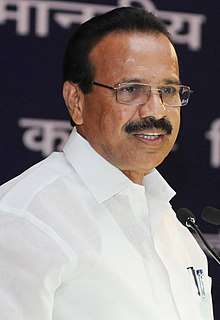Ministry of Chemicals and Fertilizers
The Ministry of Chemicals and Fertilizers in India is the federal ministry with administrative purview over three departments namely:-
- Department of Chemicals and Petrochemicals
- Department of Fertilisers
- Department of Pharmaceuticals
 Emblem of India | |
 | |
| Agency overview | |
|---|---|
| Jurisdiction | |
| Annual budget | ₹71,897 crore (US$10 billion) (2020-21 est.) [1] |
| Agency executives |
|
The Ministry is headed by the Minister of Chemicals and fertilisers. D. V. Sadananda Gowda is the current minister for the departments.[2]
Department of Chemicals and Petrochemicals
The Department of Chemicals and Petrochemicals was under the Ministry of Industry until December 1989, when it was brought under the Ministry of Petroleum and Chemicals. On June 5, 1991, the Department of Chemicals and Petrochemicals was transferred to the Ministry of Chemicals and Fertilisers.
The Department is entrusted with the responsibility of planning, development and regulations of the chemicals, petrochemicals and pharmaceutical industry sector, inducting:
- Drugs and pharmaceuticals, excluding those specifically allotted to other departments
- Insecticides, excluding the administration of the Insecticides Act, 1968 (46 of 1968).
- Molasses
- Alcohol – Industrial and Potable from the molasses route.
- Dyestuffs and dye intermediates
- All organic and inorganic chemicals not specifically allotted to any other ministry or department.
- Bhopal disaster – special laws
- Petrochemicals
- Industries relating to production of non-cellulosic synthetic fibres such as nylon, polyester, and acrylic
- Synthetic rubber
- Plastics including fabrications of plastic and moulded goods
- Planning, development and control of, and assistance to, all industries dealt with by the Department
The Department has various divisions under it. The important being:
- Chemical Division
- Petrochemicals Division
- Monitoring and Evaluation Division (M&E Division)
Attached offices
NPPA is an organization of the Government of India which was established, inter alia, to fix/ revise the prices of controlled bulk drugs and formulations and to enforce prices and availability of the medicines in the country, under the Drugs (Prices Control) Order, 1995.
The organization is also entrusted with the task of recovering amounts overcharged by manufacturers for the controlled drugs from the consumers.
It also monitors the prices of decontrolled drugs in order to keep them at reasonable levels.
Autonomous bodies
- Central Institute of Plastics Engineering and Technology (CIPET) [3]
Central Institute of Plastics Engineering & Technology (CIPET) is a premier National Institution devoted to Academic, Technology Support & Research (ATR) for the Plastics & allied industries, in India. First CIPET campus was established by Government of India in 1968 at Chennai and subsequently 14 CIPET Campuses have been established by Government of India in the country.
Today CIPET has many Campus's
- Central Institute of Plastics Engineering & Technology, Ahmedabad
- Central Institute of Plastics Engineering & Technology, Amritsar
- Central Institute of Plastics Engineering & Technology, Aurangabad
- Central Institute of Plastics Engineering & Technology, Bhopal
- Central Institute of Plastics Engineering & Technology, Bhubaneswar
- Central Institute of Plastics Engineering & Technology, Chennai
- Central Institute of Plastics Engineering & Technology, Guwahati
- Central Institute of Plastics Engineering & Technology, Hyderabad
- Central Institute of Plastics Engineering & Technology, Hajipur
- Central Institute of Plastics Engineering & Technology, Haldia
- Central Institute of Plastics Engineering & Technology, Jaipur
- Central Institute of Plastics Engineering & Technology, Imphal
- Central Institute of Plastics Engineering & Technology, Lucknow
- Central Institute of Plastics Engineering & Technology, Mysore
- Central Institute of Plastics Engineering & Technology, Khunti
- Central Institute of Plastics Engineering & Technology, Panipat
- Central Institute of Plastics Engineering & Technology, Madurai
- Central Institute of Plastics Engineering & Technology, Raipur
These are contributing through ATR services to the industries in India and Abroad, having uniform infrastructural facilities in the areas of Design, CAD/CAM/CAE, Tooling & Mould Manufacturing, Plastics processing, Testing and Quality control.
CIPET chennai also started a department called ARSTPS (Advance Research School for Technology and Product Simulation) which provides facilities in areas of Design, CAD/CAM/CAE. It also provide a ME degree program for CAD/CAM.A
PSUs and joint ventures
- Bengal Chemicals and Pharmaceuticals Limited (BCPL)
- Bramhaputra Valley Fertiliser Corporation Limited (BVFCL)
- FCI Aravali Gypsum and Minerals India Limited (FAGMIL)
- Fertilisers and Chemicals Travancore Limited (FACT)
- Fertiliser Association of India (FAI)
- Fertilizer Corporation of India (FCIL)
- Hindustan Antibiotics Limited (HAL)
- Hindustan Insecticides Limited (HIL)
- Hindustan Organic Chemicals Limited (HOCL)
- Madras Fertilizers Limited (MFL)
- National Fertilisers Limited (NFL)
- Projects and Development India Limited (PDIL)
- Rashtriya Chemicals and Fertilisers Limited (RCF)
- Bramhaputra Cracker and Polymer Limited (BCPL)
Others
- Gujarat State Fertilizers and Chemicals Limited (GSFC)
- Indian Farmers Fertiliser Cooperative (IFFCO)
- Krishak Bharati Cooperative Limited (KRIBHCO)
Ministers
- P. V. Narasimha Rao (21 June 1991 – 17 February 1994)
- Ram Lakhan Singh Yadav (17 February 1994 – 16 May 1996)
- Sis Ram Ola (29 June 1996 – 9 June 1997)
- M. Arunachalam (9 June 1997 – 19 March 1998)
- Surjit Singh Barnala (19 March 1998 – 13 October 1999)
- Suresh Prabhu (13 October 1999 – 30 September 2000)
- Sunder Lal Patwa (30 September 2000 – 7 November 2000)
- Sukhdev Singh Dhindsa (7 November 2000 – 22 May 2004)
- Ram Vilas Paswan (23 May 2004 – 22 May 2009)
- M. K. Alagiri (28 May 2009 – 20 March 2013)
- Srikant Kumar Jena (20 March 2013 – 22 May 2014) (MoS, Independent Charge)
- Ananth Kumar (26 May 2014 – 12 November 2018)
- D. V. Sadananda Gowda (14 November 2018 – Incumbent)
Ministers of State
- Mansukh L. Mandaviya (31 May 2019 – Incumbent)
References
- "Union Budget 2020-21 Analysis" (PDF). prsindia.org. 2020.
- "Statement of Srikant Kumar Jena on CCEA approval of the proposal regarding revival of five closed units of FCIL – Invest in India". investinindia.com. Retrieved 11 April 2018.
- http://www.cipet.gov.in/